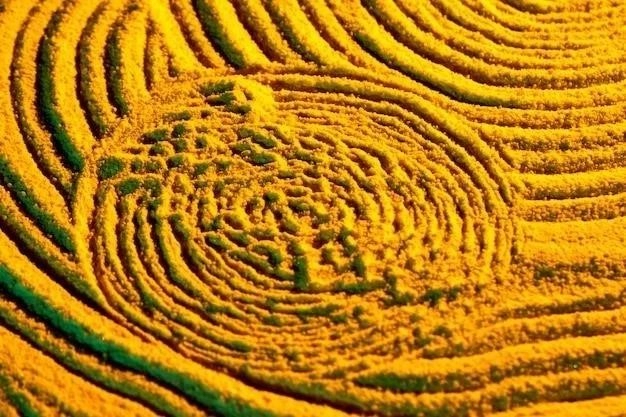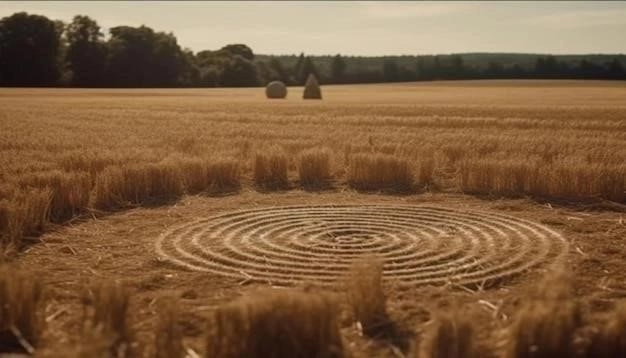The Mystery of Crop Circles: Messages from Beyond or Earthly Hoaxes?
For centuries, humanity has gazed upon the stars, pondering the vastness of the universe and the possibility of life beyond our planet. This fascination with the unknown has manifested in countless ways, from science fiction literature to the very real search for extraterrestrial intelligence (SETI). And amongst the many mysteries that fuel our curiosity, few are as intriguing and divisive as the phenomenon of crop circles.
What Are Crop Circles?
Crop circles, also known as crop formations, are patterns created by flattening a crop, typically cereal crops such as wheat, barley, or canola. These formations can range from simple circles to elaborate designs encompassing complex geometric shapes, spirals, and even pictograms. While reports of strange patterns in fields date back centuries, the phenomenon gained significant attention in the late 20th century٫ particularly in southern England.
The Extraterrestrial Hypothesis
The visually stunning nature of many crop circles, coupled with their often intricate designs, has led some to believe they are the work of something… otherworldly. Proponents of the extraterrestrial hypothesis propose several theories:
- Landing Marks for UFOs: Some believe the circles are created by the downdraft of extraterrestrial spacecraft, marking landing sites for future visits.
- Messages from Advanced Civilizations: Others interpret the complex patterns as messages or warnings from intelligent beings, attempting to communicate with humanity.
- Energetic Imprints: A further theory suggests that crop circles are not physically created but are instead energetic imprints left behind by UFOs, altering the plants structure at a cellular level.

Fueling the extraterrestrial theories are accounts of unusual phenomena associated with crop circle formations, including:
- Strange Lights: Sightings of unusual lights or orbs in the sky near crop circle sites.
- Electromagnetic Anomalies: Reports of malfunctioning electronic equipment, compass deviations, and unusual readings on electromagnetic field detectors within and around the formations.
- Altered Plant Physiology: Some studies have claimed to find physiological changes in the flattened plants, such as elongated nodes or changes in the crystalline structure, suggesting exposure to unusual energies.

The Human Touch: The Case for Hoaxes
While the extraterrestrial hypothesis holds a certain allure, the scientific community largely attributes crop circles to human ingenuity, albeit with remarkable skill and artistry.
In 1991, two men, Doug Bower and Dave Chorley, claimed responsibility for creating numerous crop circles in England throughout the 1970s and 80s. Using simple tools like planks of wood, ropes, and a rudimentary sighting device, they demonstrated how they created their intricate designs. Their confession, while initially met with skepticism, highlighted the very real possibility of human fabrication.
Since then, numerous individuals and groups have come forward to claim responsibility for creating crop circles, often showcasing their techniques and the increasingly sophisticated methods employed. These methods can include:
- Planking and Ropes: The most basic technique, involving flattening the crop by foot, using planks to maintain straight lines, and ropes for creating circles and curves.
- GPS Technology and Rollers: Modern circle makers have incorporated GPS technology for precise layout and large rollers to flatten the crop more efficiently.
- Lasers and Microwaves: There have been claims, although often unsubstantiated, of the use of lasers or microwaves to weaken the crop stalks, allowing for easier flattening.
A Question of Evidence
The debate surrounding crop circles often hinges on the interpretation of evidence, or rather, the lack thereof.
Those who favor the extraterrestrial explanation often point to the sheer complexity of some formations, arguing that the precision and intricate designs are beyond human capability; They also cite the anecdotal evidence of unusual phenomena as further proof of otherworldly involvement.
However, skeptics and scientists argue that anecdotal evidence is unreliable and often based on subjective interpretations. They emphasize that no credible scientific study has definitively proven extraterrestrial involvement in crop circle creation. Furthermore, they point out that even the most complex designs can be achieved through meticulous planning, artistic talent, and the clever application of relatively simple tools and techniques.
The Enduring Allure of the Unknown
While the scientific consensus leans heavily towards human creation, the mystery of crop circles continues to fascinate and divide. The possibility of extraterrestrial communication, however improbable, holds a powerful allure, capturing the imagination and sparking endless debate.
Ultimately, whether viewed as elaborate hoaxes or intriguing anomalies, crop circles serve as a testament to human creativity and our enduring fascination with the unknown. They remind us that even in an age of scientific advancement, there are still mysteries that challenge our understanding and invite us to contemplate the vast possibilities that lie beyond our earthly realm.

Deeper into the Labyrinth: Examining the Crop Circle Debate
The discourse surrounding crop circles extends beyond a simple dichotomy of belief or disbelief. It delves into the very nature of evidence, the limitations of human perception, and the enduring allure of the unexplained.
The Scientific Lens: Methodological Challenges and Skepticism
The scientific community, by its very nature, demands rigorous evidence and testable hypotheses. Within this framework, the study of crop circles presents significant challenges:
- Ephemeral Nature: Crop circles are, by definition, temporary phenomena. Their transient nature makes it difficult to conduct in-depth, long-term scientific studies. By the time researchers are alerted to a formation and can arrive on site, crucial evidence may be compromised or lost.
- Lack of Control Group: Unlike controlled laboratory experiments, crop circle formations occur in uncontrolled environments. This makes it difficult to isolate variables and rule out potential environmental factors that could contribute to their formation.
- Replication Issues: While some individuals have demonstrated the ability to create impressive crop circle designs, attempts to replicate the more intricate and complex formations under controlled conditions, particularly those exhibiting purported anomalies, have been largely unsuccessful.
These methodological challenges, coupled with the lack of consistent, verifiable evidence supporting extraterrestrial involvement, fuel the skepticism within the scientific community.
Beyond Belief: Exploring the Cultural Significance
Regardless of their origin, crop circles have undeniably captured the cultural imagination, permeating art, literature, and popular culture. Their symbolism is multifaceted:
- Connection to Nature: Crop circles often appear in rural landscapes, amidst fields of grain that symbolize sustenance and the cycle of life. This juxtaposition of the natural and the seemingly inexplicable evokes a sense of wonder and mystery.
- Search for Meaning: The intricate designs, particularly those incorporating geometric patterns or symbolic imagery, invite interpretation. For some, they represent a form of communication, perhaps a message of hope or warning, from an unknown intelligence.
- Challenge to Paradigms: The very existence of crop circles, particularly if attributed to non-human agency, challenges established scientific and cultural paradigms. They serve as a reminder of the vastness of the unknown and the limitations of human understanding.
A Dialogue Between Curiosity and Skepticism
The mystery of crop circles endures not because of definitive answers, but because of the questions they continue to pose. They represent a fascinating intersection of art, science, and the paranormal, inviting a dialogue between curiosity and skepticism.
While the scientific community remains rightfully cautious, acknowledging the lack of conclusive evidence for anything beyond human ingenuity, the phenomenon itself serves as a potent reminder: there is still much we do not know, and the universe is full of wonders yet to be explored.










